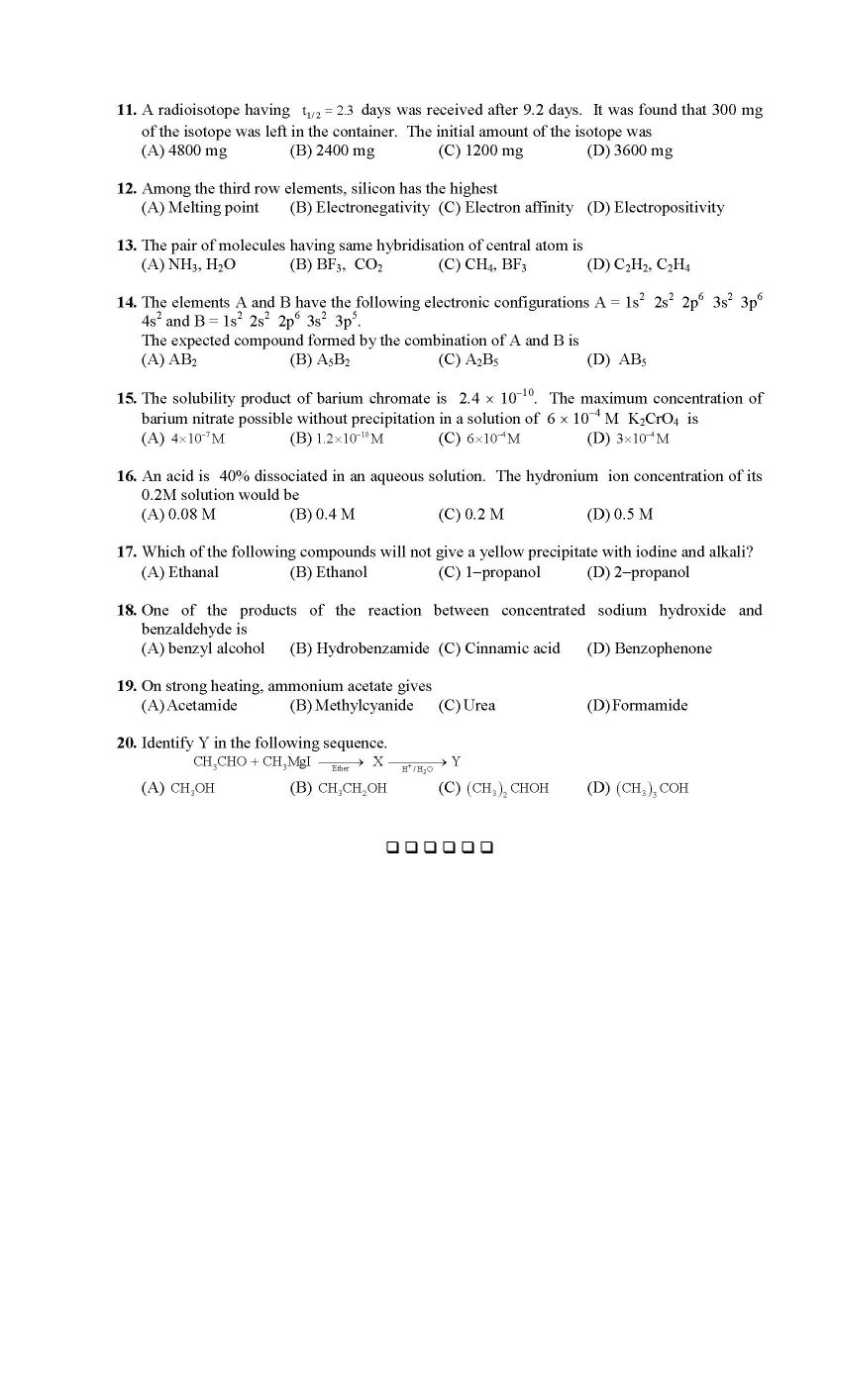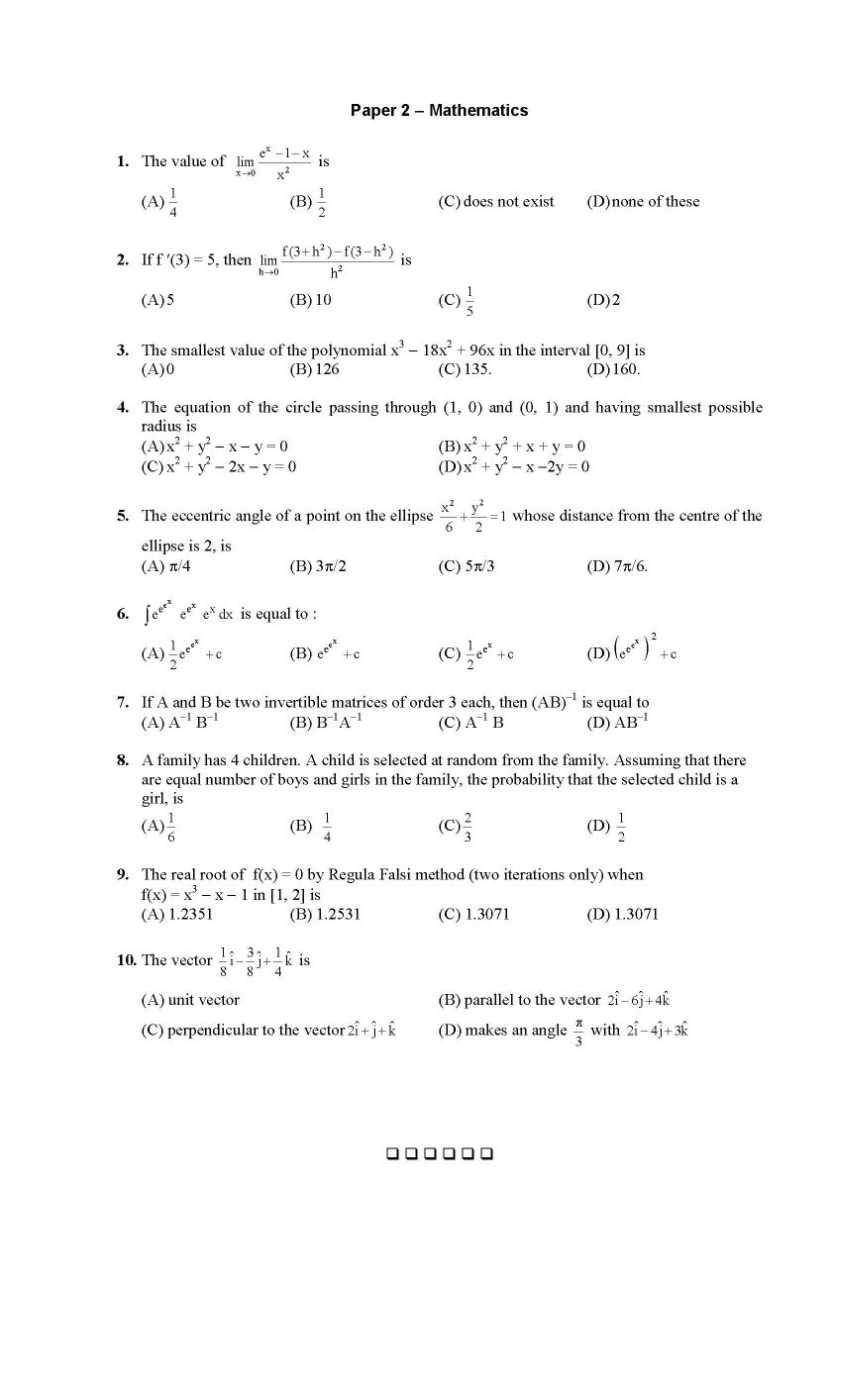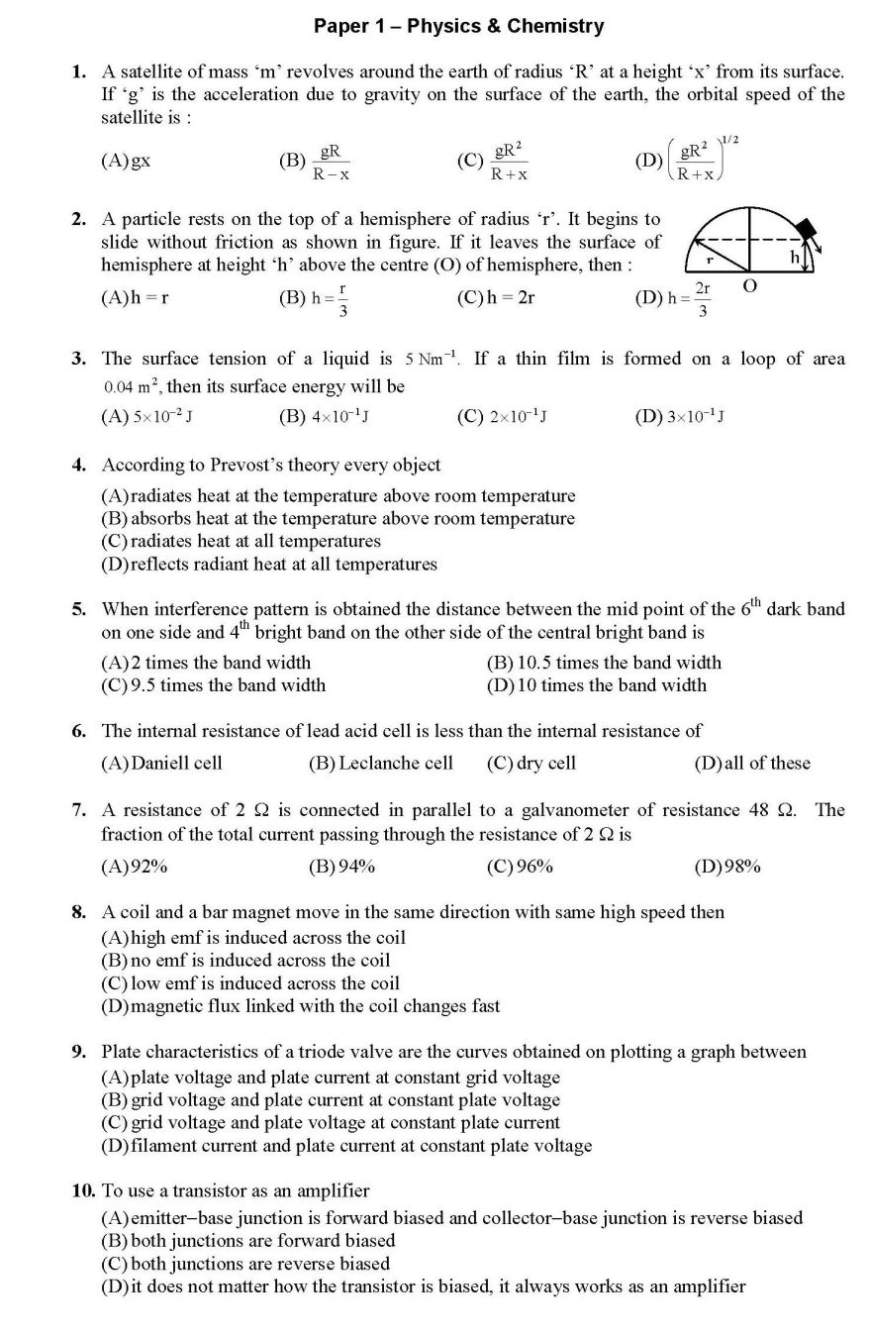|
#2
1st August 2014, 09:15 AM
| |||
| |||
| Re: Maharashtra Engineering Entrance Exam previous year question papers
As you want to get the Maharashtra Engineering Entrance Exam previous year question papers so here it is for you: Some content of the file has been given here: 1. Cells suspended in urine of a normal healthy person will a) Shrink due to loss of water c) Proliferate due to urochrome factors b) Swell, burst and finally die d) Shrink due to proliferation of protoplasm 2. Total no. of cranial nerves that carry sensory impulses are a) 4 pairs c) 7 pairs b) 3 pairs d) 5 pairs 3. A galactogogue is present in a) Flowers of Shatavari c) Leaves of Holy Basil(Tulsi) b) Roots of Asparagus racemosus d) Twigs of neem 4. Which of these as well as their isomers occur in EMP pathway? a) Glucose 6-phosphate c) 2-Phospho glyceric acid b) Dihydroxy acetone phosphate d) All of the above 5. Which of these organs are prominently affected by alcohol? a) Cerebellum c) GIT b) Liver d) All of these 6. Agents which produce allergy are known as a) Antigen c) Allergens b) Oncogenes d) Carcinogens 7. The average length of ovulatory cycle in a human female of reproductive age group is about ___ days. a) 14 c) 42 b) 28 d) 56 8. How many turns of Calvin cycle are required to reduce one molecule of CO2? a) 1 c) 36 b) 6 d) 12 or 18 9. Dry skin is NOT seen in a) Simmond's disease c) Grave's disease b) Gull's disease d) Cretinism 10. DNA fingerprinting technique can be used for a) Identification of genetic disorders such as haemophilia c) Absolute unique identity of people b) Identification of criminals from evidence such as blood, semen, etc. d) All of the above 11. In a case of sexual reproduction in angiosperms, the male plant is hexaploid(6n) and ploidy of female plant is unknown. Which of the below can be the possible ploidy of the primary endosperm nucleus produced in the process? a) 8 c) 11 b) 10 d) Data is insufficient 12. Part of the endoscopy machine that is not inserted into the body. a) Source of light c) Charge couple device(CCD) b) Probe d) Minor surgical instruments 13. Find the odd man. a) Epibiotc species c) Old endemics b) Ecological endemics d) Living fossils 14. Earthworms are put in layer no. ___ of vermibox. a) 2 c) 5 b) 3 d) 6 15. Most abundant type of W.B.C. a) Neutrophils c) Lymphocytes b) Basophils d) Monocytes 16. Example of a fomite. a) Anopheles and Culex mosquito c) Droplet nuclei containing tubercle bacilli b) Water contaminated with Salmonella d) Towels and handerchief of patient 17. Oncogenic viruses are those which cause a) Cirrhosis of liver c) Abortion in pregnancy b) Malignancy d) Slow reflexes 18. RELATED to computers. a) BMR c) CPU b) GFR d) HIV 19. NOT ASSOCIATED with closure of stomata. a) Decrease in osmotic concentration of guard cells c) Outflow of water from guard cells b) Night time d) Increase in pH of guard cells ANSWER KEYS AND EXPLANATIONS 1. Cells suspended in urine of a normal healthy person will Ans: a) Shrink due to loss of water Urine is hypertonic compared to the cell. Hence, the cell will lose water by exosmosis and shrink in size. 2. Total no. of cranial nerves that carry sensory impulses are Ans: c) 7 pairs Along with sensory type of nerves, mixed types of cranial nerves also carry sensory impulses. Thus, 3 pairs of sensory and 4 pairs of mixed, total 7 pairs out of 12 total pairs carry sensory impulses. 3. A galactogogue is present in Ans: b) Roots of Asparagus racemosus Galactogogues(or lactogogues) are substances that induce milk production and flow. Roots of Asparagus racemosus are believed to stimulate milk production and flow. 4. Which of these as well as their isomers occur in EMP pathway? Ans: d) All of the above 1. Glucose 6-phosphate : Fructose 6-phosphate 2. DHAP : 3-PGAL 3. 2-PGA : 3-PGA 5. Which of these organs are prominently affected by alcohol? Ans: d) All of these 1. Alcohol affects cerebellum and causes incoordination of body movements 2. Alcohol causes fatty liver disease in early stages and cirrhosis in late stages 3. Alcohol causes inflammation of the mucosal lining of the GIT. This results in malabsorption and nutritional deficiencies. 6. Agents which produce allergy are known as Ans: c) Allergens - Antigen = substance that can evoke immune response. - Oncogenes = mutated genes that lead to cancer. - Allergens = antigens that produce allergy. Ex: pollen grains, dust, drugs, etc. - Carcinogens are substances capable of producing cancer. They produce mutations in normal genes and convert them into oncogenes. Ex: radiations, alcohol, tar, benzopyrene, etc. 7. The average length of ovulatory cycle in a human female of reproductive age group is about ___ days. Ans: d) 56 The average of menstrual cycle is about 28 days, while that of an ovulatory cycle is about 56 days. This is because each ovary releases the ovum alternatively. 8. How many turns of Calvin cycle are required to reduce one molecule of CO2? Ans: a) 1 Cavin cycle(C3 cycle) reduces 1 CO2 molecule per turn. NB: Glucose is a 6C sugar. Thus, 6 CO2 must be reduced, or in other words, 6 turns are required for the formation of 1 glucose. 9. Dry skin is NOT seen in Ans: c) Grave's disease - Simmond's disease is hyposecretion of GH in adults. Skin is dry and wrinkled. - Gull's disease is myxoedema or hyposecretion of thyroxine in adults. Skin is dry, thick, puffy, cold, and shows loss of hair. 10. DNA fingerprinting technique can be used for Ans: b) Identification of criminals from evidence such as blood, semen, etc. DNA fingerprinting technique CANNOT be used for identification of genetic disorders and establishing unique identity of people. Reasons for them being: 1. Genetic disorders like haemophilia, black urine disease, etc. result from mutations in the coding regions of the DNA(euchromatin). However, DNA fringerprinting is based upon VNTRs which are not present in these regions. 2. People with the same genetic constitutions such as monozygotic(identical) twins have the exactly same DNA, including VNTRs. Therefore the DNA profile of identical twins will be same even though they are two different persons. [However, DNA profile of dizygotic(fraternal) twins will not be similar]. 11. In a case of sexual reproduction in angiosperms, the male plant is hexaploid(6n) and ploidy of female plant is unknown. Which of the below can be the possible ploidy of the primary endosperm nucleus produced in the process? Ans: c) 11 After studying the process of gamete formation and double fertilization in angiosperms, one can come to the following conclusions: 1. Ploidy of PEN = (Half of male parent ploidy) + ploidy of secondary nucleus. 2. Ploidy of secondary nucleus is always an even no., and never an odd no. Thus, after substituting given information: Ploidy of PEN = 3 + An even no, or we can say: (PEN - 3) should be equal to some even no. Substituting values of (a), (b) and (c) in above equation, options (a) and (b) return values 5 and 7 respectively which are not even nos. However, option (c) returns 8 which is an even no. 12. Part of the endoscopy machine that is not inserted into the body. Ans: a) Source of light For endoscopy, - The light is obtained from a cold source located outside the body. - The light is transmitted to the site of examination by the optical fibres running through the probe. - Charge couple device(CDD) is present at the tip of the tube. It acts like a video camera. It converts the reflected light into electric signals and sends them to the video monitor on which the internal view is displayed in real-time. - Minor surgical instruments can be fitted to extra attachments provided at the tip of the probe. 13. Find the odd man. Ans: b) Ecological endemics Options (a), (c) and (d) mean the same - relic endemics. Ecological endemics are paleo endemics. 14. Earthworms are put in layer no. ___ of vermibox. Ans: b) 3 Earthworms are setup into third layer of the vermibox along with dry crop residue. There are total 7 layers, nunbered 1 - 7 from bottom to top. 15. Most abundant type of W.B.C. Ans: a) Neutrophils - Neutrophils comprise about 65 - 70% of white blood cells. - Lymphocytes = 28 - 30% - Eosinophils = 3% - Monocytes = 1 - 3% - Basophils = only 0.5% [Most scarce type] 16. Example of a fomite. Ans: d) Towels and handerchief of patient Fomites are inanimate(non-living) atricles that are contaminated by the handling of the patient. They are capable of harbouring and transmitting the pathogens to other people who handle. Other examples of fomites are soap, objects, door handles, utensils, etc. 17. Oncogenic viruses are those which cause Ans: b) Malignancy Oncogenic viruses are those which cause cancer or malignancy. Ex: Cancer of the cervix(part of uterus) is mostly caused by Human Papilloma Virus(HPV). 18. RELATED to computers. Ans: c) CPU BMR = Basal Metabolic Rate; GFR = Glomerular Filtration Rate, HIV = Human Immunodeficiency Virus. 20. Inarching is Ans: c) Approach grafting - Whip grafting is also known as tongue grafting. - Cleft grafting is a.k.a. wedge grafting. - Inarching is a.k.a. approach grafting.    |


